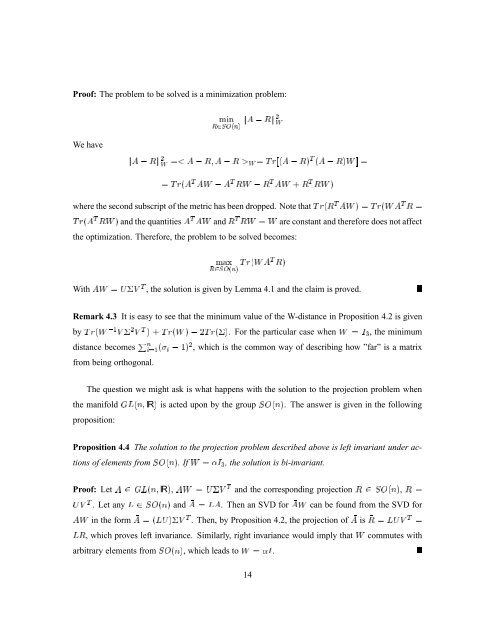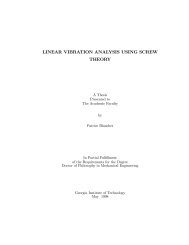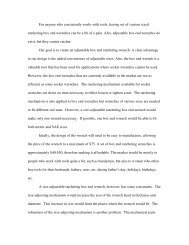New metrics for rigid body motion interpolation - helix
New metrics for rigid body motion interpolation - helix
New metrics for rigid body motion interpolation - helix
Create successful ePaper yourself
Turn your PDF publications into a flip-book with our unique Google optimized e-Paper software.
Proof: The problem to be solved is a minimization problem:<br />
We have<br />
min kA , Rk 2 W<br />
R2SO(n)<br />
kA , Rk 2 W = W = Tr[(A , R) T (A , R)W ]=<br />
= Tr(A T AW , A T RW , R T AW + R T RW )<br />
where the second subscript of the metric has been dropped. Note that Tr(R T AW )=Tr(WA T R =<br />
Tr(A T RW ) and the quantities A T AW and R T RW = W are constant and there<strong>for</strong>e does not affect<br />
the optimization. There<strong>for</strong>e, the problem to be solved becomes:<br />
max Tr(WA T R)<br />
R2SO(n)<br />
With AW = U V T , the solution is given by Lemma 4.1 and the claim is proved.<br />
Remark 4.3 It is easy to see that the minimum value of the W-distance in Proposition 4.2 is given<br />
by Tr(W ,1 V 2 V T P )+Tr(W ) , 2Tr(). For the particular case when W = I 3 , the minimum<br />
n<br />
distance becomes ( i=1 i , 1) 2 , which is the common way of describing how ”far” is a matrix<br />
from being orthogonal.<br />
The question we might ask is what happens with the solution to the projection problem when<br />
the manifold GL(n; IR) is acted upon by the group SO(n). The answer is given in the following<br />
proposition:<br />
Proposition 4.4 The solution to the projection problem described above is left invariant under actions<br />
of elements from SO(n). IfW = I 3 , the solution is bi-invariant.<br />
Proof: Let A 2 GL(n; IR), AW = U V T and the corresponding projection R 2 SO(n), R =<br />
UV T . Let any L 2 SO(n) and A = LA. ThenanSVD<strong>for</strong>AW can be found from the SVD <strong>for</strong><br />
AW in the <strong>for</strong>m A =(LU )V T . Then, by Proposition 4.2, the projection of A is R = LUV T =<br />
LR, which proves left invariance. Similarly, right invariance would imply that W commutes with<br />
arbitrary elements from SO(n), which leads to W = I.<br />
14













